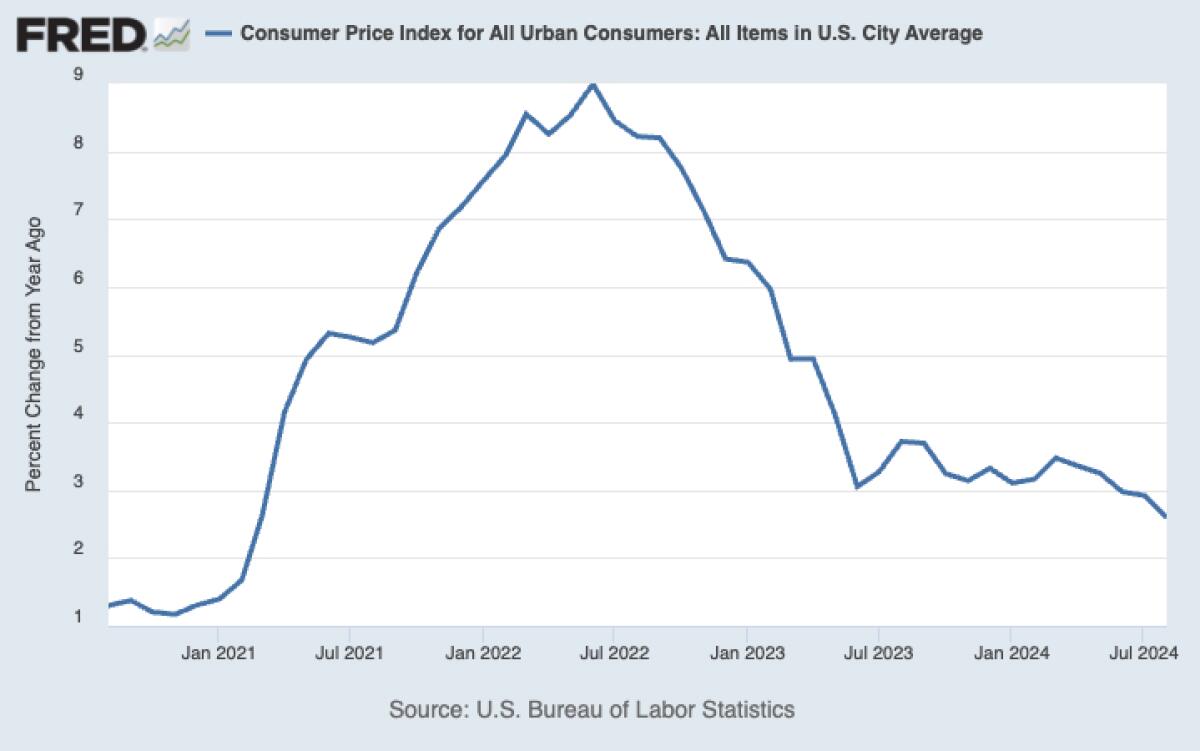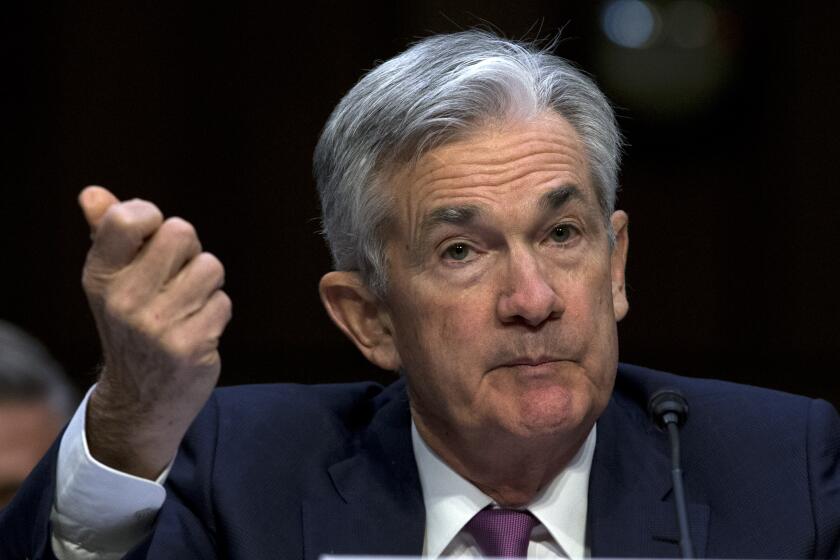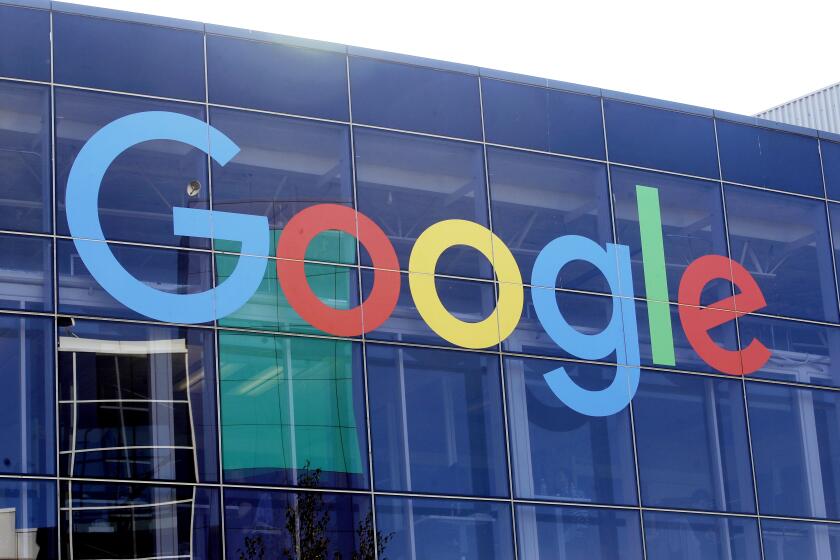American economists and consumers got inflation wrong during its recent surge. They still do

- Share via
In the latest video of GOP vice presidential candidate JD Vance to go viral but not in a good way, he’s seen standing in front of a grocery display of eggs and blaming Democratic presidential candidate Kamala Harris for driving the cost of this staple up to $4 per dozen.
That’s “thanks to Kamala Harris’ inflationary policies,” Vance states. “It’s because she cast the deciding vote on the Inflation Explosion Act.”
A few points about that: As multiple observers pointed out within moments of the video’s appearance on social media Saturday, the price tag on the packages of a dozen eggs directly behind him wasn’t $4, but $2.99.
The good ship Transitory was a crowded one, with most mainstream analysts and advanced-economy central bankers on board.
— Fed Chair Jerome Powell
Also, of course, the legislation he’s referring to is the Inflation Reduction Act of 2022, which passed the Senate without a single Republican vote, and on which Harris was permitted by the U.S. Constitution to cast a tie-breaking vote.
Also, the reason egg prices are where they are today has nothing to do with the legislation, but with the bird flu, which first struck in early 2022 and has necessitated the slaughter of more than 90 million chickens.
Get the latest from Michael Hiltzik
Commentary on economics and more from a Pulitzer Prize winner.
You may occasionally receive promotional content from the Los Angeles Times.
Finally, inflation didn’t “explode” following passage of the Inflation Reduction Act. Rather, it has come sharply, inexorably down, from an annualized rate of 8.21% in August 2022, when President Biden signed the measure, to 2.6% this August, roughly corresponding to the Federal Reserve’s target rate. In other words, by most reckonings inflation has been beaten.
One can’t really blame a politician for lying about a fundamental fact, any more than one can punish a dog for drinking out of the toilet. It’s what they do.
But Vance’s misstatements point to an important feature of Americans’ thinking about inflation in recent years: We haven’t understood it from the moment it first appeared in early 2021. We still don’t. But no one should feel ashamed, because economists and policymakers have gotten it wrong too.
Let’s start with the most fundamental debate among the policymakers: whether inflation would be “transitory” or long-lasting. The Federal Reserve first used the term in a policy statement in April 2021, after the annualized inflation rate had climbed to 2.6%. (“Inflation has risen, largely reflecting transitory factors.”)
As Fed Chair Jerome H. Powell recollected in a speech last month, “the good ship Transitory was a crowded one, with most mainstream analysts and advanced-economy central bankers on board.” Beginning in October 2021, however, “the data turned hard against the transitory hypothesis. Inflation rose and broadened out from goods into services. It became clear that the high inflation was not transitory, and that it would require a strong policy response.”
Even Federal Reserve economists know that wages had no effect on inflation. But that doesn’t stop Fed Chair Jerome H. Powell from harping on labor costs and ignoring the real culprits.
The “transitory” camp was ridiculed as Pollyannaish. The “strong policy response” Powell referred to was the Fed’s raising of short-term interest rates 11 times, a total of 5.25 percentage points, from March 2022 through July 2023.
Yet in retrospect, team transitory was right. Compared with some previous post-war inflationary episodes, this one was brief. Previous run-ups in prices included a 27-month period immediately after World War II, when consumer spending after years of wartime austerity combined with supply shortages as industry began its conversion of output from military hardware to consumer goods.
Then there was the granddaddy of them all, two decades of recurrent inflationary peaks from the mid-1960s through the early 1980s that encompassed price pressures from the 1960s economic expansion and the oil price shocks of the 1970s.
The most recent episode started in April 2021 and was largely played out by June 2023, or about 26 months. That may not have been as brief as government economists expected at the outset, but it wasn’t as severe as several earlier postwar episodes. Nor did the rate approach earlier peaks: In 1947, the annualized inflation rate, as measured by the consumer price index, reached 20%; during the oil shocks, there were two peaks — 12.1% in December 1974 and 14.4% in May 1980. The recent run-up peaked at about 9% in June 2022.

The price increases of the pandemic period were sufficiently large and rapid to spook economists and consumers alike. Initially, Powell had said that the first glimmers of inflation appeared “likely to pass through fairly quickly without the need for a monetary policy response” — the very credo of Camp Transitory.
In November 2021, however, Powell told Congress that it was “probably a good time to retire that word.” The Fed’s monetary policy response was launched March 18, 2022, with a quarter-point hike in interest rates.
The Fed, however, was fighting the last war, deploying outdated weaponry. Inflation in the 2020s resembled that of the immediate postwar period, when consumers were flush with cash — saved up during the war in the 1940s, and accumulated from stimulus payments and the falloff in spending on entertainment, travel and services during the pandemic.
Hiltzik: These companies cynically used global crises to juice profits — and brought us inflation
The Fed has ignored how corporate profits drove inflation. That left PepsiCo, Tyson Foods and Procter & Gamble free to jack up prices and blame it on the pandemic and Ukraine war.
In both cases, resurgent demand ran up against a lack of supply — the slow retooling of factories from armaments to consumer goods in the 1940s, and the chaos in the supply chain caused by the COVID-19 pandemic in the 2020s (exacerbated by another oil shock resulting from the Russian invasion of Ukraine).
Economic prescriptions had an old-school quality. A notable case was that of former Treasury Secretary Lawrence Summers, who in June 2022 invoked the conventional wisdom that the best way to battle inflation is to reduce employment.
“We need five years of unemployment above 5% to contain inflation,” Summers told the audience at a London conference. “In other words, we need two years of 7.5% unemployment or five years of 6% unemployment or one year of 10% unemployment.”
At the time, the U.S. unemployment rate of 3.6% was the lowest since the 1960s. Summers’ words implied that 5.8 million to 15 million Americans would have to be rendered jobless in order to bring down inflation.
Yet as it turned out, inflation came down to Earth without a significant increase in unemployment. In August, the civilian unemployment rate was 4.2%. It never came close to 5%, much less 6% or 7.5% or 10%, even as the inflation rate plummeted from 9% in June 2022 to 2.6% last month.
That demonstrates that the Fed’s traditional anti-inflation arsenal was, in this case, aimed at the wrong target. America wasn’t in the throes of unsustainably high consumer demand, but a temporary — call it “transitory” — spike. The real inflation culprits were immune to the Fed’s powers.
That point was made incisively by Sen. Elizabeth Warren (D-Mass.) during a hearing of the Senate Banking Committee in June 2022, just after the Fed raised interest rates by three-quarters of a percentage point, its biggest increase since 1994.
Citing the spike in gasoline prices caused by the invasion of Ukraine, Warren asked Powell, “Will gas prices go down as a result of your interest rate increase?”
“I would not think so, no,” he replied.
For Republicans, the inflation issue is an election boon. But why don’t they propose any ideas for doing something about it?
“Rate hikes won’t break up monopolies,” she continued. “Rate hikes won’t straighten out the supply chain, or speed up ships, or stop a virus that is still causing lockdowns in some parts of the world.”
Nor did higher rates moderate another important contributor to inflation, corporate profiteering. Businesses attributed their price increases to higher labor costs and other costs, but as the Bureau of Economic Analysis found, from the first quarter of 2020 through the end of 2021, corporate after-tax profits rose by nearly 14% while labor costs rose by only 7%.
Economists connected price increases at large companies to their executives’ public indications that the pandemic, along with oil price shocks resulting from the Russian invasion of Ukraine and supply logjams at American ports, gave them headroom to raise prices without a significant backlash from consumers.
“Publicly reported supply chain bottlenecks and cost shocks,” wrote Isabella M. Weber and Evan Wasner of the University of Massachusetts Amherst, “serve to create legitimacy for price hikes and create acceptance on the part of consumers to pay higher prices.”
The Fed’s turbocharged response to inflation — notwithstanding the perception of some economists that its interest rate increases were too late and too small — is understandable. Policymakers tend to fret that consumer consumers react to inflation fears by spending more to get ahead of expected price increases, fueling more inflation. or less spending, as the case may be.
As Treasury Secretary Janet L. Yellen warned in 2021, “inflation can be a self-fulfilling prophecy.” That’s especially true when an economically illiterate news media stokes consumer fears. A classic example was an inexcusably misinformed report by CNN in November 2021 featuring a Texas couple who said they were buying 12 gallons of milk a week for their nine children and that they were staggering under an increase in the price of milk price to $2.79 a gallon from $1.99 a few months ago.
In fact, the average price of a gallon of milk hadn’t been $1.99 in close to 40 years. Indeed, when accounting for inflation, its price had actually come down over the previous 25 years or so. CNN didn’t bother to do its homework.
No one can deny that the prices of some goods are higher today than they were in 2020. Wages have also risen, though in some segments they have barely kept up with inflation, or fallen behind.
The question is what to do about that? In some categories, prices are already heading to pre-pandemic levels. The average price of gasoline is $3.22 per gallon as I write, according to the AAA; it was $3.84 a year ago and is down from its peak of $5.03 in June 2022.
If the Republicans have ideas on how to bring prices down, they haven’t shared them with the public. One wouldn’t expect them to be on board, for instance, with a Democratic platform that involves blocking competition-killing corporate mergers, such as the proposed merger of grocery giants Albertsons and Kroger.
Instead, they’ll probably just continue faking the numbers, as Vance did about eggs. They’re counting on people being as confused about inflation as they always have been.
More to Read
Get the latest from Michael Hiltzik
Commentary on economics and more from a Pulitzer Prize winner.
You may occasionally receive promotional content from the Los Angeles Times.














